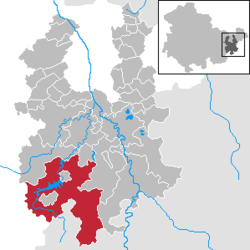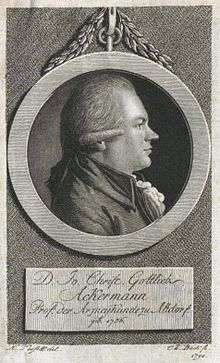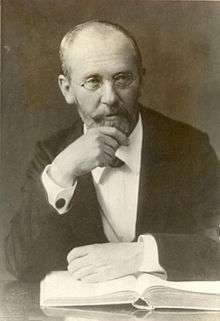Zeulenroda-Triebes
Zeulenroda-Triebes is a German town in the district of Greiz in the state of Thuringia.
Zeulenroda-Triebes | |
|---|---|
 Town hall | |
 Coat of arms | |
Location of Zeulenroda-Triebes within Greiz district  | |
 Zeulenroda-Triebes  Zeulenroda-Triebes | |
| Coordinates: 50°38′55″N 11°58′50″E | |
| Country | Germany |
| State | Thuringia |
| District | Greiz |
| Government | |
| • Mayor | Nils Hammerschmidt (Ind.) |
| Area | |
| • Total | 134.72 km2 (52.02 sq mi) |
| Elevation | 415 m (1,362 ft) |
| Population (2018-12-31)[1] | |
| • Total | 16,487 |
| • Density | 120/km2 (320/sq mi) |
| Time zone | CET/CEST (UTC+1/+2) |
| Postal codes | 07931–07937, 07950 |
| Dialling codes | 036628, 036622 |
| Vehicle registration | GRZ, ZR |
| Website | www.zeulenroda-triebes.de |
Zeulenroda-Triebes is situated in the south of Greiz in the mountains of the Thuringian Slate Mountains (Thüringer Schiefergebirge), on the border with Saxonia. The population of Zeulenroda-Triebes in 2006 was about 18000. The largest company is Bauerfeind AG. The most famous sight in the town is the neoclassical town hall, built in 1827. Zeulenroda-Triebes is also known for the International Thuringia Women's Cycling Tour.
Zeulenroda-Triebes is twinned with the town of Strabane in Northern Ireland as well as with Giengen an der Brenz (Baden-Württemberg, Germany).
Jürgen Raab, a former East German football player, was born in Zeulenroda-Triebes. Paul Herman Geithner (1902–1972), was born in Zeulenroda and immigrated with his parents to Philadelphia, Pennsylvania in 1908.[2] His grandson, Timothy Geithner, was the 75th United States Secretary of the Treasury, serving under President Barack Obama.
Zeulenroda unt Bf station lies on the Werdau–Mehltheuer railway.
History
Zeulenroda was mentioned in a document as early as 1325. The village became a town in 1438. Zeulenroda belonged to the principality of the House of Reuss Elder Line for several centuries. On April 16, 1945 the United States Army took over Zeulenroda without a battle. On July 1 the Red Army occupied the town. In 1949 Zeulenroda and Triebes became a part of the German Democratic Republic. After German reunification in 1990, the Free State of Thuringia was reestablished. Zeulenroda merged with Triebes in 2006. The new name of the town is Zeulenroda-Triebes.
.jpg)
Population development of Zeulenroda
In 1908 the population of Zeulenrodas reached the 10,000 mark. In 1946, the city had grown to more than 14,000 inhabitants through many resettlers. At the beginning of the 1990s more than 15,000 people lived in Zeulenroda. In recent years the number of inhabitants has declined slightly.
- 1830: 8.449
- 1905: 9.776
- 1910: 10.389
- 1925: 11.047
- 1933: 12.247
- 1939: 12.688
- 1946: 14.039
- 1950: 13.694
- 1960: 13.684
- 1981: 14.709
- 1995: 15.021
- 2000: 14.600
- 2005: 13.434
Local council
The elections in May 2014 showed the following results:
- CDU 11 seats
- The Left 5 seats
- SPD 3 seats
- BIZ 2 seats
- TV 2 seats
- FDP 1 seat
BIZ means Bürgerinitiative für sozialverträgliche Abgaben und Leistungsgerechtigkeit in Zeulenroda und Umgebung e. V.
TV means: Wählergemeinschaft Thüringer Vogtland
Sons and daughters of the city
In the municipalities that today belong to the town of Zeulenroda-Triebes, the following persons were born:


- Johann Christian Gottlieb Ackermann (1756-1801), physician
- Gustav Schreck (1849-1918), Thomaskantor in Leipzig
- Heinrich Seeling (1852-1932), architect of numerous theaters (Theater am Schiffbauerdamm in Berlin, theater in Gera)
- Fritz Wächtler (1891-1945), National Socialist politician
- Gerd Schenker (born 1948), percussionist
- Jürgen Raab (born 1958), football player and coach
- Thomas Barth (born 1960), cyclist
- Henning Bürger (born 1969), football player and coach
- Doreen Dietel (born 1974), actress
- Alexander John (athlete) (born 1986), hurdler
- René Enders (born 1987), track cyclist
References
- "Bevölkerung der Gemeinden, erfüllenden Gemeinden und Verwaltungsgemeinschaften nach Geschlecht in Thüringen Gebietsstand: 31.12.2018". Thüringer Landesamt für Statistik (in German). September 2019.
- "geithner". freepages.genealogy.rootsweb.ancestry.com. Retrieved 2014-07-12.
External links
| Wikisource has the text of the 1911 Encyclopædia Britannica article Zeulenroda. |
- Official website of Zeulenroda-Triebes (in German) (needs Java)
- Unofficial website of Zeulenroda-Triebes
- Landkreis Greiz
| Wikimedia Commons has media related to Zeulenroda-Triebes. |
| Wikisource has original text related to this article: |